Wimborne AGS Show, 2015
The name may have changed, but the good things we came to expect of the Summer South Show live on: light, airy conditions for both show and trade stands, a friendly welcome, unobtrusive but efficient organisation and offers of help from Bill Squire and his admirable team, who also make great efforts to promote this show beyond AGS circles, under the ‘Rocky Flower Show’ brand. Great cakes, too!
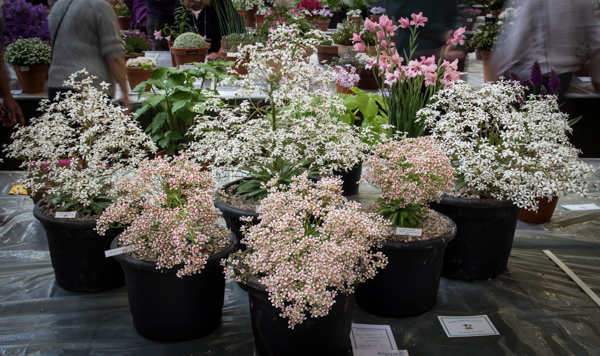
The view from the hall entrance was dominated by the vast inflorescences of Saxifraga cotyledon and its hybrids, now hitting their peak in the south of England. Of particular interest was a group of six of these seasonal giants, including three named clones of the Southside Seedling Group, entered by Michael Sullivan in Class 1. There seemed constantly to be a knot of people around them, comparing their merits and trying to pin down the differences. The judges found them ‘not sufficiently distinct’ which in turn caused some discussion but prompted a helpful reminder of the judges’ rule of thumb: if we were to pull out all the labels, could we be sure of putting them back in the right pots? Nevertheless, they were widely admired.
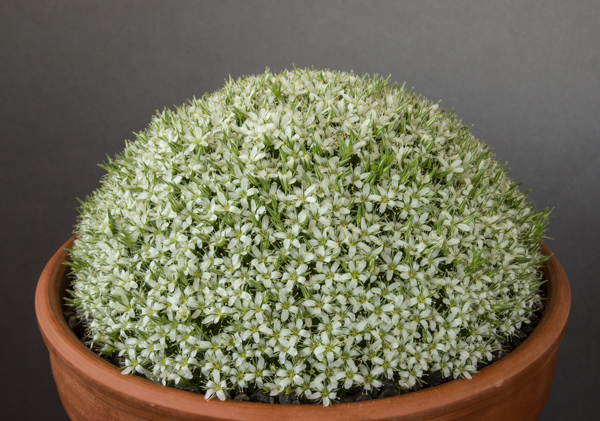
Magnificent only from much closer range was the Farrer Medal-winning Arenaria (Eremogone) hookeri var. desertorum (Lee and Julie Martin), beautifully and uniformly studded with small white flowers. Lee modestly talked down the difficulty of growing this widespread cushion plant of the American West, emphasising that the problem is getting it to flower well. He feels certain that a pot-bound condition is necessary. This one, bought from a nursery as a small plant nine years ago, is grown in a compost of one part leaf-mould, half of loam, two of grit, half of perlite and of coarse sand, to which is added a pinch of John Innes base fertilizer. It’s in a clay pot, plunged in the alpine house, but has previously lived in an outside frame. Lee suggested trialling it on the open rock garden - if you can get hold of it.
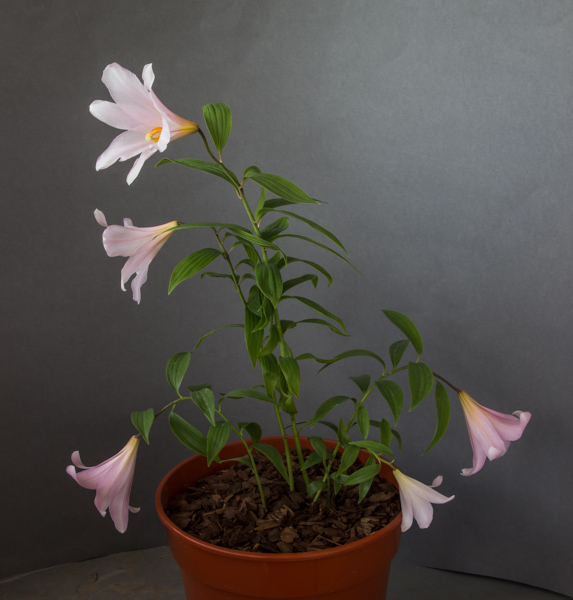
A well-flowered pot of the Japanese Lilium rubellum (Diane Clement) was much talked about, each stem carrying a single large, pink, terminal flower. The weight of these causes the more slender stems to arch outwards, while the stoutest stems stand almost upright. There is general agreement that aphid-borne virus is this plant’s great enemy. ‘I’m petrified of virus’ admitted Diane. Her solution: ‘Provado’. Adapted to spending a long winter under snow cover, this plant is kept in an Access frame, alongside pots of Cypripedium and Erythronium, covered in winter but open to the elements in summer.
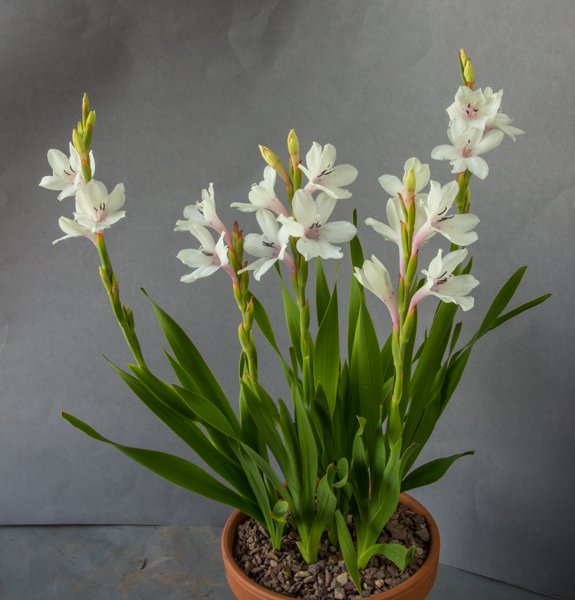
Western Cape bulbs, flowering at the end of their winter growing season, are a regular feature of this show. As usual, George Elder brought some lovely examples, including one of the few Watsonia species in scale for the show bench, W. humilis. Its flowers, white from a pink tube (all-pink forms exist), are carried on stout 30cm stems, which die down decisively after flowering.
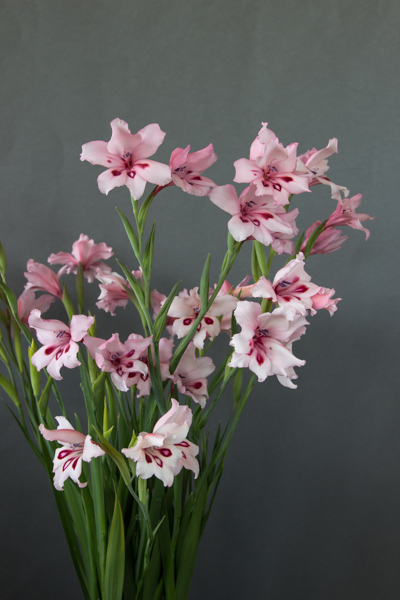
For sheer floral impact, however, this was trumped by an impressive pot of bolt-upright Gladiolus carneus (Ivor Betteridge). It is a variable species: at 45cm this was a rather tall form, with soft pink flowers marked carmine on the three lower tepals. Despite being a winter grower, it is gaining some hardiness credentials on the open rock garden in colder, if not wetter areas.
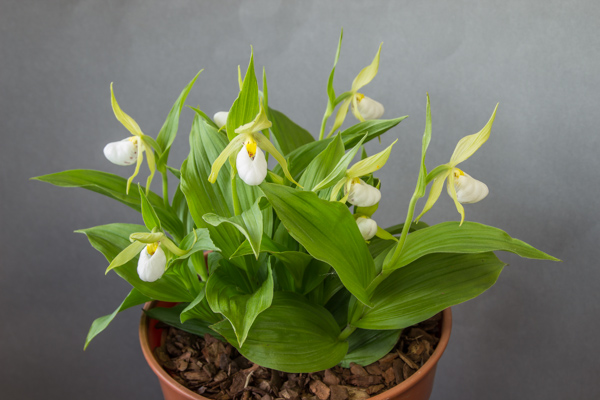
Several fine orchids were to be seen. Diane Clement’s pot of Cypripedium cordigerum was particularly impressive, not in the least ‘drawn’ and uniform with seven fully open flowers and buds to follow. This is not the largest-flowered species, and on this compactly grown example the flowers looked perfectly in scale. It is grown in 75% perlite, the remaining quarter being mostly leaf-mould.
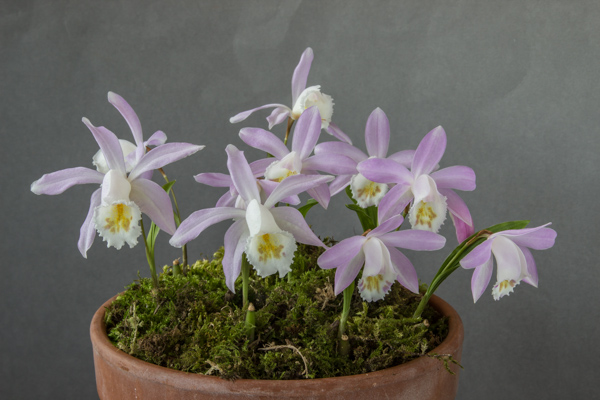
Of the other orchids, with the peak flowering of brasher Pleione species and hybrids behind us, demure P. chunii, grown in pure Sphagnum moss by Ian Robertson, was a beautiful ambassador for its genus.
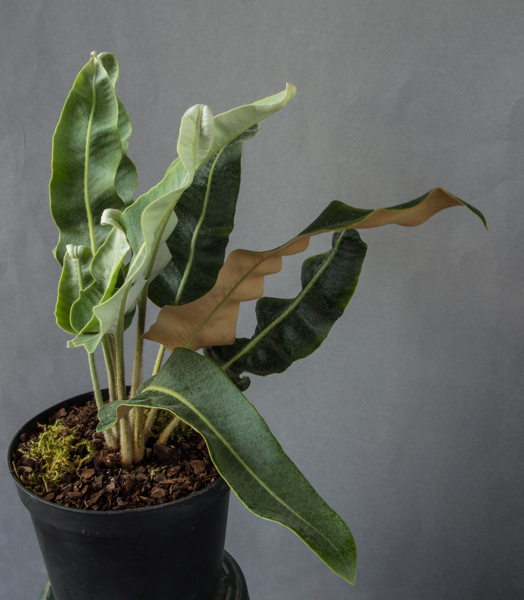
The ‘green’ classes − ferns, foliage plants and conifers − were well filled. Among the ferns, we were particularly happy to see the Chinese Pyrrosia sheareri, an unusual member of a large genus related to Polypodium, raised from spores by its owner, Ray Drew. The upright, undivided fronds are grey on the upper surface, and can survive for several years. First-year fronds have silvery grey hairs on the backs; by the second year they have turned golden brown. The sight of both together is rather surprising. By their third year, Ray feels they start to look tatty: he had removed them from the show plant. He reckons it needs protection from wet, not only in winter but in summer too, so it’s not likely to have a future in the open garden.
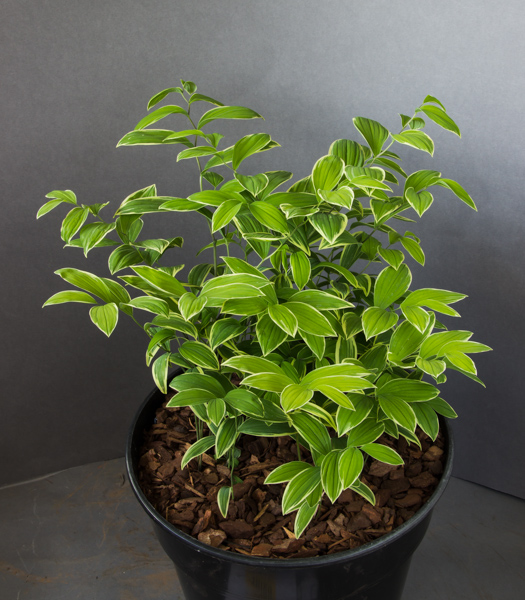
Among foliage plants, we were impressed by a pot of Uvularia caroliniana ‘Variegata’, although it did not catch the judges’ eyes. This slight, slender species has relatively far-creeping rhizomes and tends to make a much sparser clump than its familiar relatives. This example looked remarkably dense, demonstrating not one but two of the skilful exhibitor’s techniques. Ivor Betteridge explained that he had first knocked the top off the compost, once the stems were well developed, then carefully pulled them closer together, refilling with grit to hold them in place. Then, for the show, he had double potted and dressed with grit, the compactness of the central group emphasised by the surrounding ring of bare grit.
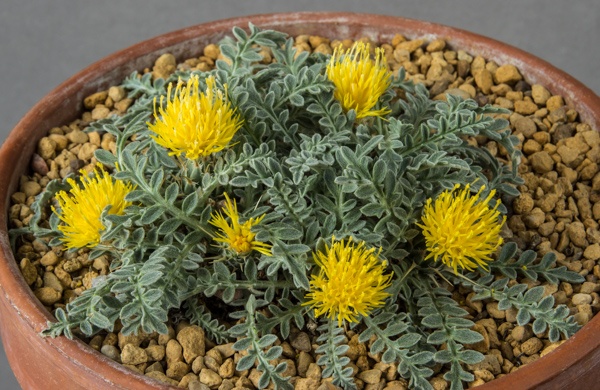
In the ‘new’ and ‘rare’ classes, Centaurea pestalozzae, a diminutive Turkish alpine with 2cm wide, bright yellow heads held tightly against the blue-grey pinnate leaves, was particularly impressive. Martin & Anna Sheader grew this from seed sourced on the stony ridges of Boz Dağ. They consider that only now, at six years old, has it begun to take on its true character, having looked rather loose initially. As well as being valuable in identification, the diverse involucral bracts of Centaurea species can be very beautiful. Here, each is tipped with a vicious yellow-brown spine, almost invisible at normal viewing distance. Martin was on hand to pick the plant up for a demonstration, rather gleefully we felt.
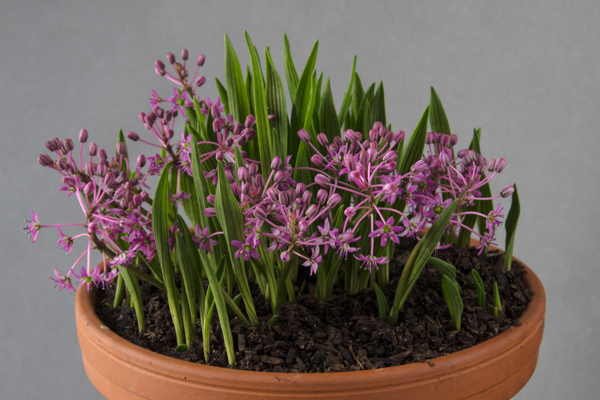
It’s too easy to pass quickly over the Novice Section and miss plants not to be seen elsewhere in the show. An example was Ledebouria cooperi, a summer-growing South African Scilla relative shown by Patricia ‘Paddy’ Parmee, putting her toe in the water of a national show for the first time and, to her delight, receiving the Downland Trophy for the best plant in the Section. On an open rock garden in Hampshire, it survives for Paddy but does not flower; in a pot the small purple flowers (from buds resembling tiny bunches of grapes) are produced freely. Other growers from central southern England have had much the same experience. Overall, though, entries in the novice classes were rather few, surely an opportunity for members of the local groups to emulate her success in the future?
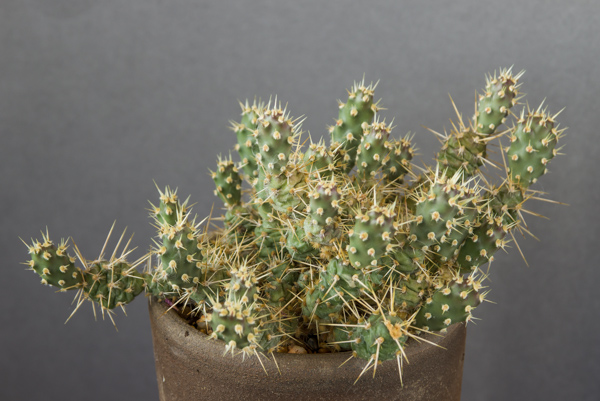
Finally, the trade stands are rarely mentioned in reports, but interesting plants are to be found here, some of which may appear on the show benches in years to come. In order to sell small offsets, Kevin Hughes showed a mature specimen of Opuntia fragilis, from a collection made in the eastern Siskiyous, an area which experiences not only cold winters but also very significant rainfall. He has seen it growing on mossy boulders running with water in spring, just feet from Trillium albidum. Whilst this species may have red or yellow flowers, some marginal populations do not flower at all, spreading by pieces which break off. Kevin’s plants never flower, but cats make a nuisance of themselves, carrying bits away in their fur. He has grown it for some years entirely unprotected in a gritty raised bed. A conundrum for exhibitors: here is a small, hardy plant from the mountains, but as a cactus which never flowers, is there any show class in which it could be entered?
Authors: Sarah and Julian Sutton
Photographer: Jon Evans
